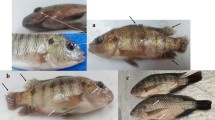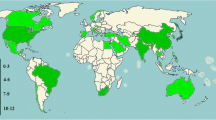Abstract
We investigated the prevalence, antimicrobial susceptibility, antimicrobial resistance and virulence genes of Salmonella isolates recovered from humans and different species of animals. Out of 1231 samples, 88 (7.15%) Salmonella isolates were obtained, among which 21 (23.86%) belonged to Salmonella enterica subsp. enterica sero var. Weltevreden, 22 (25%) to S. Enteritidis, 16 (18.2%) to S. Typhi and 14 (15.9%) to S. Newport; 7 (7.95%) isolates were untypable. Among the 88 isolates, 65.90% showed resistance to gentamicin, 61.36% to tetracycline, 61.18% to cefotaxime, 48.86% to trimethoprim, 45.45% to ampicillin, 11.36% to ceftriaxone, 10.22% to chloramphenicol and 7.95% each to ciprofloxacin and cefepime. Most of the isolates were susceptible, with a low MIC (≤ 0.25 μg/ml) value, to cefepime, cefotaxime, ciprofloxacin, ceftriaxone and co-trimoxazole and with a moderate MIC (0.5–4 μg/ml) to ampicillin, tetracycline, gentamicin and chloramphenicol. The resistance genes blaTEM, tetA and dfrA12 were most prevalent, irrespective of the host of origin of the isolates. While invA was used for molecular detection of Salmonella, other virulence genes, viz. sipA, sipB, sipC, stn and pagN, were also detected in all Salmonella isolates. A total of 38.64% isolates were multidrug-resistant (MDR), and various virulence genes were present among the isolated serovars. This study highlights the importance of continuous monitoring and surveillance for pathogenic Salmonella and their potential risks to both humans and animals.
Similar content being viewed by others
Data availability
Not applicable.
Code availability
Not applicable.
References
Ed-Dra A, Fouzia RF, Bouchra K, Abdellah El A, Amal A, Brahim B (2017) Prevalence, molecular and antimicrobial resistance of Salmonella isolated from sausages in Meknes, Morocco. Microb Pathog 105:340–345
Borah P, Porwollik S, Desai P, Nayak P, Borah PP, Cheng P, McClelland M (2017) A simplified multiplex PCR-based typing method for common Salmonella enterica serovars supported by online server-based detection system. Indian J Med Res 2(146):272–280
Botti V, Navillod FV, Domenis L, Orusa R, Pepe E, Robetto S, Guidetti C (2013) Salmonella spp. and antibiotic-resistant strains in wild mammals and birds in north-western Italy from 2002 to 2010. Vet Ital 49(2):195–202
Brolund A, Sundqvist M, Kahlmeter G, Grape M (2010) Molecular characterization of trimethoprim resistance in Escherichia coli and Klebsiella pneumoniae during a two-year intervention on trimethoprim use. PLoS One 5(2):e9233
CDC Antibiotic Resistance Threats in the United States (2019) Atlanta, GA: U.S. Department of Health and Human Services. CDC: 2019
Chakraborty S, Roychoudhury P, Samanta I, Subudhi PK, Lalhruaipuii DM, De A, Bandyopadhayay S, Joardar SN, Mandal M, Qureshi A, Dutta TK (2020) Molecular detection of biofilm, virulence and antimicrobial resistance associated genes of Salmonella serovars isolated from pig and chicken of Mizoram, India. Indian J Anim Res 54:608–613
Chen Z, Bai J, Wang S, Zhang X, Zhan Z, Shen H, Zhang H, When J, GaoY LM, Zhang J (2020) Prevalence, antimicrobial resistance, virulence genes and genetic diversity of Salmonella isolated from retail duck meat in southern China. Microorganisms 8:444
Choudhury M, Borah P, Sarma HK, Barkalita LM, Deka NK, Hussain IM (2016) Multiplex PCR assay for detecting some major virulence genes of Salmonella enteritidis from diverse sources. Curr Sci 111:7
Clinical and Laboratory Standards Institute (CLSI) (2019) Performance Standards for Antimicrobial Susceptibility Testing. 29th ed. CLSI supplement M100 (ISBN978–1–68440-033-1)
Clouthier SC, Muller Doran JL, Collinson SK, Kayl WW (1993) Characterization of three Fimbrial genes sefABC of Salmonella Enteritidis. J Bacteriol 175(9):2523–2533
Ed-Dra A, Filali FR, Khayi S et al (2019) Antimicrobial resistance, virulence genes, and genetic diversity of Salmonella enterica isolated from sausages. Eur J Microbiol Immunol (Bp) 9(2):56–61
Esteban JE, Oporto B, Aduriz G, Just R, Hurtado A (2008) A survey of food-borne pathogens in free-range poultry farms. Int J Food Microbiol 123:177–182
Galanis E, Lo W, Fo DMA, Patrick ME, Binsztein N, Cieslik A, Chalermchikit T (2006) Web-based surveillance and global Salmonella distribution 2000-2002. Emerg Infect Dis 12(3):381–388
Garcia-Gil A, Galan-Enriquez CS, Perez-Lopez A, Nava P, Alpuche-Aranda C, Ortiz-Navarrete V (2018) SopB activates the Akt-YAP pathway to promote Salmonella survival within B cells. Virulence 9(1):1390–1402. https://doi.org/10.1080/21505594.2018.1509664
Giannella RA (1996) Salmonella. In: Baron S (ed) Medical microbiology, 4th edn. University of Texas Medical Branch at Galveston, Galveston
Hale CR, Scallan E, Cronquist AB, Dunn J, Smith K, Robinson T, Lathrop S, Tobin-D'Angelo M, Clogher P (2012) Estimates of enteric illness attributable to contact with animals and their environments in the United States. Clin Infect Dis 54(Suppl 5):S472–S479
Issenhuth-Jeanjean S, Roggentin P, Mikoleit M, Guibourdenche M, Pinna E, Nair S, Fields PI, Weill F (2014) Supplement 2008-2010 (no. 48) to the White e Kauffmanne Le minor scheme. Rise Microbiol 165:526–530
Jin C, Gibani MM, Pennington SH, Liu X, Ardrey A, Aljayyoussi G et al (2019) Treatment responses to Azithromycin and Ciprofloxacin in uncomplicated Salmonella Typhi infection: A comparison of clinical and microbiological data from a controlled human infection model. PLoS Negl Trop Dis 13(12):e0007955. https://doi.org/10.1371/journal.pntd.0007955
Kaur J, Jain SK (2012) Role of antigens and virulence factors of Salmonella enterica serovar Typhi in its pathogenesis. Microbiol Res 167:199–210
Klemm EJ, Shakoor S, Page AJ, Qamar FN, Judge K, Saeed DK, Wong VK, Dallman TJ, Nair S, Baker S, Shaheen G, Qureshi S, Yousafzai MT, Saleem MK, Hasan Z, Dougan G, Hasan R (2018) Emergence of an extensively drug-resistant Salmonella enterica serovar Typhi clone harboring a promiscuous plasmid encoding resistance to fluoroquinolones and third-generation cephalosporins. M Biol 9:e00105–e00118
Kumar Y, Sharma A, Sehgal R, Kumar S (2009) Distribution trends of Salmonella serovars in India (2001-2005). Trans R Soc Trop Med Hyg 103:390–394
Li B, Yang X, Tan H, Ke B, He D, Wang H, Chen Q, Ke C, Zhang Y (2018) Whole genome sequencing analysis of Salmonella enterica serovar Weltevreden isolated from human stool and contaminated food samples collected from the southern coastal area of China. Int J Food Microbiol 266:317–323
Li Q, Yin J, Li Z, Li Z, Du Y, Guo W, Bellefeur M, Wang S, Shi H (2019) Serotype distribution, antimicrobial susceptibility, antimicrobial resistance genes and virulence genes of Salmonella isolated from a pig slaughterhouse in Yangzhou. China AMB Expr 9:210
Li R, Lai J, Wang Y, Liu S, Li Y, Liu K, Shen J, Wu C (2013) Prevalence, and characterization of Salmonella species isolated from pigs, ducks and chickens in Sichuan Province, China. Int J Food Microbiol 163:14–18
Magiorakos AP, Srinivasan A, Carey RB, Carmeli Y, Falagas ME, Giske CG, Harbarth S, Hindler JF, Kahlmeter G, Olsson-Liljequist B, Paterson DL, Rice LB, Stelling J, Struelens MJ, Vatopoulos A, Weber JT, Monnet DL (2012) Multidrug-resistant, extensively drug-resistant and pandrug-resistant bacteria: an international expert proposal for interim standard definitions for acquired resistance. Clin Microbiol Infect 18(3):268–281
Monte DFM, Sellera FP (2020) Salmonella. Emerg Infect Dis 26(12):2955. https://doi.org/10.3201/eid2612.ET2612
Murray CE, Varga C, Ouckama R, Guerin MT (2021) Temporal study of Salmonella enterica serovars isolated from fluff samples from Ontario poultry hatcheries between 2009 and 2018. Pathogens 11(1):9
Murugkar HV, Rahman H, Dutta PK (2003) Distribution of virulence genes in Salmonella serovars isolated from man & animals. Indian J Med Res 117:66–70
Nair DVT, Kumar V, Anup KJ (2018) Antibiotic-resistant Salmonella in the food supply and the potential role of antibiotic alternatives for control. Foods 7: 167
Prager R, Fruth A, Tsachape H (1995) Salmonella enterotoxin (stn) gene is prevalent among strains of Salmonella enterica, but not among Salmonella bongori and other Enterobacteriaceae. FEMS Immunol Med Microbiol 12:47–50
Purkayastha A, Borah P, Sharma RK, Borah PP (2015) Multiplex PCR for detection of virulence gene profiles of Salmonella isolates from animals and man. Indian J Appl Res 5(12):142–144
Radhouani H, Silva N, Poeta P, Torres C, Correia S, Igrejas G (2014) Potential impact of antimicrobial resistance in wildlife, environment and human health. Front Microbiol 5:23
Rahman H (2006) Prevalence & phenotypic expression of sopB gene among clinical isolates of Salmonella enterica. Indian J Med Res 123:83–88
Rahman H, Barman NN, Patgiri GP, Kalita N (1997) Outbreak of salmonellosis in broiler flocks in Assam. Indian J Comp Microbiol Immunol Infect Dis 18:56–58
Rajkhowa S, Neher S, Pegu SR, Sarma DK (2018) Bacterial diseases of pigs in India: a review. Indian J comp Microbiol Immunol Infect Dis 39(Spl Issue):29–37
Sharma I, Das K (2016) Detection of invA gene in isolated Salmonella from marketed poultry meat by PCR assay. J Food Process Technol 7(3):1000564
Skold O (2001) Resistance to trimethoprim and sulfonamides. Vet Res 32:261–273
Schwarz S, Silley P, Simjee S, Woodford N, van Duijkeren E, Johnson AP, Gaastra W (2010) Assessing the antimicrobial susceptibility of bacteria obtained from animals. Vet Microbiol 141(1–2):1–4
Tanmoy AM, Westeel E, De Bruyne K, Goris J, Rajoharison A, Sajib MSI, Van Belkum A, Saha SK, Komurian-Pradel F, Endtz HP (2018) Salmonella enterica serovar Typhi in Bangladesh: exploration of genomic diversity and antimicrobial resistance. M Biol 9:e02112–e02118
Threlfall EJ (2002) Antimicrobial drug resistance in Salmonella: problems and perspectives in food- and water-borne infections. FEMS Microbiol Rev 26(2):141–148
Voetsch AC, Van Gilder TJ, Angulo FJ, Farley MM, Shallow S, Marcus R, Cieslak PR, Deneen VC, Tauxe RV (2004) FoodNet estimate of the burden of illness caused by non-typhoidal Salmonella infections in the United States. Clin Infect Dis 38(Suppl. 3):S127–S134
Waghamare RN, Paturkar AM, Vaidya VM, Zende RJ, Dubal ZN, Dwivedi A, Gaikwad RV (2018) Phenotypic and genotypic drug resistance profile of Salmonella serovars isolated from poultry farm and processing units located in and around Mumbai city. India Vet World 11(12):1682–1688
Walia K, Madhumathi J, Veeraraghavan B, Chakrabarti A, Kapil A, Ray P, Singh H, Sistla H, Ohri VC (2019) Establishing Antimicrobial Resistance Surveillance & Research Network in India: journey so far. Indian J Med Res 149:164–179
Wang X, Biswas S, Paudyal N, Pan H, Li X, Fang W, Yue M (2019) Antibiotic resistance in Salmonella typhimurium isolates recovered from the food chain through national antimicrobial resistance monitoring system between 1996 and 2016. Front Microbiol 10:985
WHO (2017) Prioritization of pathogens to guide discovery, R&D of new antibiotics for drug-resistant bacterial infections, including tuberculosis. World Health Organization, Geneva 2017(WHO/EMP/IAU/2017.12) (license: CC BY-NC-SA 3.0 IGO)
Wu B, Abdelaziz ED, Hang P, Chenghang D, Chenghao J, Min Y (2021) Genomic investigation of Salmonella isolates recovered from a pig slaughtering process in Hangzhou. China Front Microbiol 12:1843
Yingyu L, Jindou J, Abdelaziz ED, Xiaomeng L, Xianqi P, Lining X, Qingyong G, Gang Y, Min Y (2021) Prevalence and genomic investigation of Salmonella isolates recovered from animal food chain in Xinjiang, China. Food Res Int 142(110198):ISSN 0963-9969
Acknowledgments
The authors acknowledge Department of Biotechnology (DBT), Govt of India for their financial support to conduct the entire research work.
Funding
The study was funded by Department of Biotechnology (DBT), Govt of India, Grant no. BT/375/NE/TBP/2012.
Author information
Authors and Affiliations
Contributions
Conceptualization-Probodh Borah; Methodology, Formal Analysis and investigation: Rupam Dutta, Iftikar Hussain, Naba Kumar Deka, Leena Das, Mridusmita Choudhury; Writing – original draft preparation: Naba Kumar Deka, Dipika Malakar, Girin Hazarika; Writing – review and editing: Luit Moni Barkalita, Probodh Borah, Rupam Dutta; Funding acquisition, Resources and Supervision: Probodh Borah.
Ethics declarations
Competing interests
The authors declare no competing interests.
Ethics approval
For collecting fecal and swab samples from different sources, informed consent was taken from the individuals/owners of the animals. Tissue samples were collected from dead animals by taking consent from the concerned authority conducting postmortem examination. The ethical approval for the entire work was obtained vide Approval No. 770/ac/CPCSEA/FVSc/AAU/IAEC/16–17/388.
Consent to participate
Necessary consent from the concerned authority of each farm and/or individual was taken before collecting the samples.
Consent for publication
All the authors have given their consent for the publication of the manuscript in this form.
Additional information
Publisher’s note
Springer Nature remains neutral with regard to jurisdictional claims in published maps and institutional affiliations.
Supplementary Information
ESM 1
(DOCX 24 kb)
Rights and permissions
About this article
Cite this article
Borah, P., Dutta, R., Das, L. et al. Prevalence, antimicrobial resistance and virulence genes of Salmonella serovars isolated from humans and animals. Vet Res Commun 46, 799–810 (2022). https://doi.org/10.1007/s11259-022-09900-z
Received:
Accepted:
Published:
Issue Date:
DOI: https://doi.org/10.1007/s11259-022-09900-z




